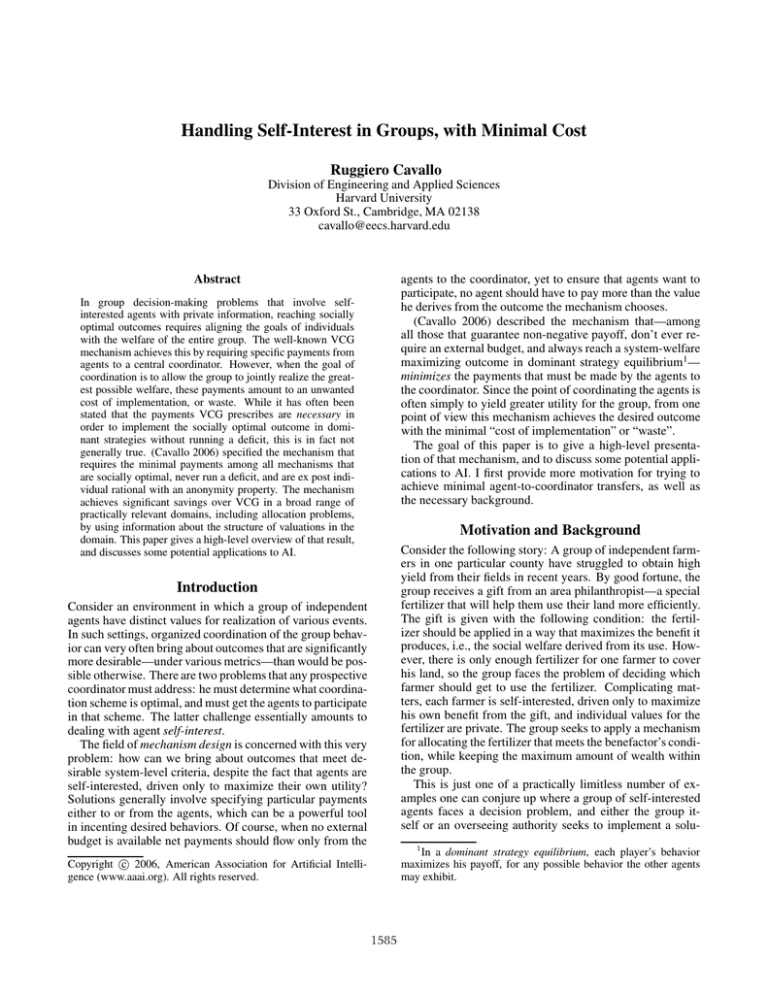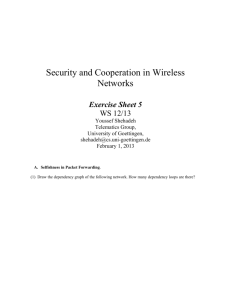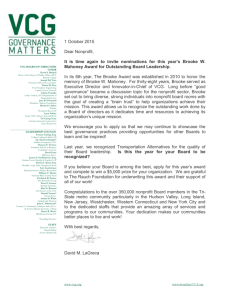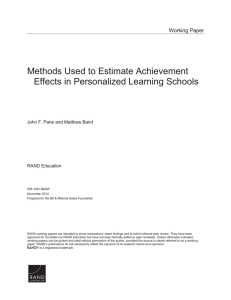Handling Self-Interest in Groups, with Minimal Cost Ruggiero Cavallo
advertisement

Handling Self-Interest in Groups, with Minimal Cost
Ruggiero Cavallo
Division of Engineering and Applied Sciences
Harvard University
33 Oxford St., Cambridge, MA 02138
cavallo@eecs.harvard.edu
Abstract
agents to the coordinator, yet to ensure that agents want to
participate, no agent should have to pay more than the value
he derives from the outcome the mechanism chooses.
(Cavallo 2006) described the mechanism that—among
all those that guarantee non-negative payoff, don’t ever require an external budget, and always reach a system-welfare
maximizing outcome in dominant strategy equilibrium1—
minimizes the payments that must be made by the agents to
the coordinator. Since the point of coordinating the agents is
often simply to yield greater utility for the group, from one
point of view this mechanism achieves the desired outcome
with the minimal “cost of implementation” or “waste”.
The goal of this paper is to give a high-level presentation of that mechanism, and to discuss some potential applications to AI. I first provide more motivation for trying to
achieve minimal agent-to-coordinator transfers, as well as
the necessary background.
In group decision-making problems that involve selfinterested agents with private information, reaching socially
optimal outcomes requires aligning the goals of individuals
with the welfare of the entire group. The well-known VCG
mechanism achieves this by requiring specific payments from
agents to a central coordinator. However, when the goal of
coordination is to allow the group to jointly realize the greatest possible welfare, these payments amount to an unwanted
cost of implementation, or waste. While it has often been
stated that the payments VCG prescribes are necessary in
order to implement the socially optimal outcome in dominant strategies without running a deficit, this is in fact not
generally true. (Cavallo 2006) specified the mechanism that
requires the minimal payments among all mechanisms that
are socially optimal, never run a deficit, and are ex post individual rational with an anonymity property. The mechanism
achieves significant savings over VCG in a broad range of
practically relevant domains, including allocation problems,
by using information about the structure of valuations in the
domain. This paper gives a high-level overview of that result,
and discusses some potential applications to AI.
Motivation and Background
Consider the following story: A group of independent farmers in one particular county have struggled to obtain high
yield from their fields in recent years. By good fortune, the
group receives a gift from an area philanthropist—a special
fertilizer that will help them use their land more efficiently.
The gift is given with the following condition: the fertilizer should be applied in a way that maximizes the benefit it
produces, i.e., the social welfare derived from its use. However, there is only enough fertilizer for one farmer to cover
his land, so the group faces the problem of deciding which
farmer should get to use the fertilizer. Complicating matters, each farmer is self-interested, driven only to maximize
his own benefit from the gift, and individual values for the
fertilizer are private. The group seeks to apply a mechanism
for allocating the fertilizer that meets the benefactor’s condition, while keeping the maximum amount of wealth within
the group.
This is just one of a practically limitless number of examples one can conjure up where a group of self-interested
agents faces a decision problem, and either the group itself or an overseeing authority seeks to implement a solu-
Introduction
Consider an environment in which a group of independent
agents have distinct values for realization of various events.
In such settings, organized coordination of the group behavior can very often bring about outcomes that are significantly
more desirable—under various metrics—than would be possible otherwise. There are two problems that any prospective
coordinator must address: he must determine what coordination scheme is optimal, and must get the agents to participate
in that scheme. The latter challenge essentially amounts to
dealing with agent self-interest.
The field of mechanism design is concerned with this very
problem: how can we bring about outcomes that meet desirable system-level criteria, despite the fact that agents are
self-interested, driven only to maximize their own utility?
Solutions generally involve specifying particular payments
either to or from the agents, which can be a powerful tool
in incenting desired behaviors. Of course, when no external
budget is available net payments should flow only from the
1
In a dominant strategy equilibrium, each player’s behavior
maximizes his payoff, for any possible behavior the other agents
may exhibit.
c 2006, American Association for Artificial IntelliCopyright gence (www.aaai.org). All rights reserved.
1585
tion that maximizes total group welfare. Other instances include: a group of housemates deciding who gets to use a
jointly-owned automobile on a given night; a group of siblings choosing who should get the last piece of an apple pie;
and perhaps more relevantly, allocation of time on a publicly
owned super-computer to researchers with distinct projects.
satisfying these constraints and maintaining an anonymity
property, which I describe in the next section. I present the
solution as a “redistribution mechanism” because of the relationship it bears to the well-known Vickrey-Clarke-Groves
(VCG) mechanism. VCG specifies each C−i above to be the
net welfare that agents other than i would have achieved if i
were not present. Under VCG:
Ti =
v̂j (o∗ ) −
v̂j (o∗−i )
(2)
Efficient mechanisms: the Groves family
Reaching a socially optimal (also called efficient) outcome
despite agent self-interest can be achieved by establishing
specific monetary payment rules between agents and a coordinator. Let I be the set of agents, and O be the set of possible outcomes or decisions that are available. The Groves
family of mechanisms (Groves 1973) achieves efficiency by:
1) querying each agent i ∈ I for the value v̂i (o) he places on
each outcome o ∈ O; 2) implementing the socially highest
valued outcome according to what the agents report, which I
denote o∗ ; and 3) making the following transfer payment Ti
to each agent i, where C−i is any quantity that is completely
independent of what i reports:
Ti =
v̂j (o∗ ) − C−i ,
(1)
j∈I\{i}
j∈I\{i}
where o∗−i
is the outcome that maximizes welfare (according
to reports) among agents other than i. It has been shown
(Krishna & Perry 1998) that VCG maximizes revenue among
mechanisms with the properties we desire. Thus, one can
conveniently frame the goal of minimizing revenue as that of
redistributing back among the agents the net payments made
in VCG, which I will refer to as the “VCG surplus”.
It has often been stated that no such redistribution is possible in dominant strategy equilibrium (see, e.g., Ephrati &
Rosenschein 1991), but this is actually not true when there
is certain known information about agent valuations prior
to agent reports. In reality, it is quite rare (if ever) that
nothing at all is known about agent valuations. To mention
one broad and important domain where this doesn’t hold,
consider standard single-item allocation problems. Here we
know that each agent values only the outcome in which he
is allocated the good (in our farming example, each farmer
only obtains value when he gets to use the fertilizer). In
this domain and many others, significant redistribution of
the VCG surplus is, in fact, possible.
j∈I\{i}
Each agent thus receives a payment equal to the total utility derived by all other agents combined, minus some charge
that is out of his control. Since he can’t affect the charge, he
will act to maximize the first term plus his own value for
the chosen outcome, which aligns his interest completely
with that of the entire group and makes truth-telling a dominant strategy. In fact it is known (Green & Laffont 1977;
Holmstrom 1979) that when agent valuation spaces are
smoothly connected, any mechanism that achieves the efficient outcome in dominant strategy equilibrium is a Groves
mechanism.2 If this strong form of efficiency is what we’re
after, then, our flexibility is limited to how we define the
agent-independent charge term, C−i .
When C−i is defined such that Ti is negative, agents are
required to make payments, rather than receive them. While
there are many examples of decision-problems where maximizing “revenue”—the sum of the payments from the agents
to a decision-maker—is desired, in those mentioned above
and many others, it would clearly be preferable to minimize
such payments.
If we wish to guarantee that no agent will be worse off for
having participated, i.e., achieve ex post individual rationality (IR),
we must specify C−i such that it is never greater
than j∈I\{i} v̂j (o∗ ) (the “Groves payment”) plus vi (o∗ )
(the reward i naturally receives from o∗ ’s implementation).
If we wish to maintain an ex post no deficit property, that
places other constraints on each C−i .
Previous approaches
There have been several previous approaches seeking to
achieve improved budget-balance over VCG, all of which
give up one or more of the following criteria: efficiency,
ex post IR, ex post no deficit. The d’AGVA mechanism
(d’Aspremont & Gerard-Varet 2002) is perfectly budgetbalanced but not ex post IR; (Faltings 2004) also achieves
perfect budget-balanced, but in a mechanism that is efficient
for only a subgroup of agents; the threshold rule of (Parkes,
Kalagnanam, & Eso 2001) achieves perfect budget-balance
in an exchange setting at the expense of truthfulness (and
thus efficiency). Finally, the mechanism of (Bailey 1997)
also redistributes VCG surplus, but there are instances for
which it runs a deficit.
The Result
The key insight of the mechanism proposed in (Cavallo
2006) is this: if it can be determined that a certain amount
of VCG surplus will definitely exist, independent of what a
particular agent reports to the coordinator, then we can redistribute surplus back to that agent without creating an incentive to misreport valuation information. It will be useful
to explicitly define this agent-independent guarantee on surplus. First, observe that the total VCG surplus is simply the
sum of the payments made from agents to the coordinator:
VCG surplus =
v̂j (o∗−i ) − v̂j (o∗ )
(3)
Improving on VCG
The result reviewed in this paper specifies the mechanism
that minimizes the payments required of the agents while
2
A smoothly connected domain is one in which any two valuations an agent could report have the property that one can be
differentiably deformed into the other. This holds quite broadly (as
Holmstrom (1979) notes, for “all practical purposes”).
i∈I j∈I\{i}
1586
Definition 1. (Surplus-guarantee Sl ) The minimum
amount of VCG surplus that could be realized, taken over
all possible instantiations of agent l’s valuation function vl :
v̂j (o−i ) − v̂j (o )
(4)
Sl = min
v̂l
bid, regardless of the number of agents. To more clearly see
the relationship between the basic Groves mechanism (BG)
with C−i defined to be 0, VCG, and RMg , consider the
outcomes they yield in the following 4-agent, single-item
allocation example. Let π(M ) be the payoff (value of the
outcome, plus transfer) received under mechanism M , and
let C denote the coordinator.
i∈I j∈I\{i}
where o and o−i are analogs of o∗ and o∗−i computed with
the hypothetical v̂l in place of the actually reported value.
agent
1
2
3
4
C
The proposed redistribution mechanism pays out a portion
of the VCG surplus to each agent that is directly proportional
to the agent’s surplus-guarantee level.
Definition 2. (Redistribution Mechanism RMg )
1. Each agent i communicates to the coordinator his valuation function v̂i .
2. The coordinator implements the outcome that maximizes social welfare according to reports.
3. Each agent is assigned the following transfer payment,
where n is the number of agents:
S
i
(5)
v̂j (o∗ ) − v̂j (o∗−i ) +
Ti =
n
bid
15
12
8
4
-
π(BG)
15
15
15
15
−45
π(VCG)
3
0
0
0
12
π(RMg )
5
2
3
3
2
Table 1: Comparison of mechanisms in an allocation problem.
The basic Groves mechanism runs an enormous deficit,
while VCG eliminates the deficit and in fact yields a large
revenue. RMg keeps significantly more wealth among the
agents, while still avoiding a deficit. It turns out that no
mechanism that always maintains the budgetary and incentive properties we seek keeps more wealth among the agents
than RMg in any problem instance (where an instance is
defined by a specific set of agent valuations).
j∈I\{i}
Theorem 1. (Cavallo 2006) For smoothly connected valuation spaces, among all efficient, ex post IR, no deficit, and
surplus-anonymous mechanisms that can be implemented in
dominant strategy equilibrium, RMg maintains the most
wealth within the group of agents in every problem instance.
RMg is strategyproof: reporting v̂i equal to the true valuation vi is always a dominant strategy, for every agent
i. Then Ti above will always be non-positive, between
−vi (o∗ ) and 0, so the mechanism is ex post IR yet never
runs a deficit. RMg is also surplus-anonymous: any two
agents i and j with Si = Sj receive the same amount of “redistribution” of the VCG surplus. Note that any traditionally
anonymous mechanism (i.e., one that does not discriminate
at all based on agent identity) is also surplus-anonymous.
The mechanism has a very simple and intuitive form when
agent valuations are completely exclusive, as in single-item
allocation problems, where only one agent has non-zero
value for any given outcome. In such settings, values are
“bids” for the item, and RMg reduces to the following:
Potential Applications to AI
The result described here is obviously not one that pertains
specifically to artificial intelligence; it is rather a general observation about how one can achieve a system of decisionmaking that reaches socially-optimal outcomes while incurring minimal cost. But there are many problems within AI
to which the proposed mechanism may be fruitfully applied.
Designing mechanisms to effectively deal with selfinterest in multi-agent systems has been a compelling and
growing topic of study in recent AI literature (see Dash, Jennings, & Parkes 2003); moreover, often these mechanisms
are designed primarily to yield payoff to the participating
agents. The application of RMg would seemingly be a
more appropriate solution than VCG or other mechanisms
in these environments. Perhaps the most natural applications
for the mechanism are problems in which scarce resources
must be allocated. Here I will go through one such example
in detail, then touch briefly on a second application area.
Definition 3. (RMg in single-item allocation settings)
1. Each agents reports its value (bid) for the item.
2. The coordinator allocates the item to the agent with the
highest bid.
3. The winning agent pays the coordinator an amount
equal to the second highest bid.
4. The coordinator pays the winner and the second highest bidder an amount equal to the third highest bid divided by the number of agents, n, and pays all other
agents the second highest bid divided by n.
Application: Job scheduling
Consider the problem of allocating processor time on a
server to computational tasks, each of which is “owned” by a
selfish human client who has private knowledge of his own
value for having the task completed. Say there are 3 jobs
requesting processor time in a single day, each of which requires half a day to complete; so there are 3 clients, each
owning 1 job, competing for 2 time-slots. Moreover, assume
clients obtain different value depending on whether the job is
completed in the first or second time-slot, and that no value
Each agent’s redistribution payment is n1 times the second highest bid among the (n − 1) other agents. In singleitem allocation settings, RMg is perfectly budget-balanced
in the limit. That is, as the number of agents approaches
infinity the payments go to 0, regardless of the agent valuations. In VCG waste is always equal to the second highest
1587
is obtained if the job is not completed (the day is a “hard
deadline”). Consider valuations of the following form:
Agent
1
2
3
v(time1 )
10
7
6
each agent has control over some subset of the problem variables, which are constrained by the values of other agents’
variables. Here agents’ costs/rewards may be private, and
achieving the optimal solution could require their communication amongst the group. There have been VCG-based
proposals for handling incentive issues in this environment
(see, e.g., Faltings & Macho-Gonzalez 2003); the “waste”
incurred by VCG would be minimized by RMg , which
would be significant in settings where valuations have some
degree of mutual exclusivity.
v(time2 )
5
4
2
Table 2: Valuations of 3 agents over 2 time-slots.
It is helpful to consider expansion of the above representation into a table of values over every possible outcome. I
denote the outcome in which agent i’s job is processed in the
first slot and j’s in the second as (i, j).
outcome
(1, 2)
(1, 3)
(2, 1)
(2, 3)
(3, 1)
(3, 2)
v1
10
10
5
0
5
0
v2
4
0
7
7
0
4
Conclusion
Coordinating decision-making in groups of independent
agents requires disarming self-interest, by creating an environment in which each individual is best off when the group
is best off. It is desirable that the mechanism used to achieve
this solution not run a deficit, and at the same time guarantee that individuals won’t be worse off from participating; it
is also often desirable that the mechanism not discriminate
among agents based on their identity. The mechanism RMg
specified in (Cavallo 2006) minimizes implementation cost
among all solutions that reach system-welfare maximizing
outcomes with these properties. RMg can be considered a
superior solution to VCG for domains in which the objective
is to maximize payoff to the agents.
v3
0
2
0
2
6
6
Table 3: Enumeration of agent values, with outcome o∗ in bold.
If the server is a public resource established with the mandate of increasing benefit to the social good, it will be desirable to maintain as much wealth as possible among the jobowners. We can compare the results that VCG and RMg
yield when applied to this example. The outcome o∗ that
maximizes social welfare is (1, 2), which yields total value
14. To compute the transfer payments, we need also to recognize the outcomes that would have been implemented in
the absence of each of the agents. We have the following:
o∗−1 = (3, 2); o∗−2 = (1, 3); o∗−3 = (1, 2).
To execute RMg we additionally need to determine the
agent-independent surplus-guarantee Si for each agent i. In
this domain the VCG surplus is minimized when an agent
reports value 0 for each time-slot, so it is simple to compute S1 = 3, S2 = 4, and S3 = 3. We can now determine the payoff πi for each agent i under VCG and RMg
∗
(both mechanisms will reach
the efficientoutcome o ). Under VCG πi = vi (o∗ ) + j=i vj (o∗ ) − j=i vj (o∗−i ). Un
der RMg , πi = vi (o∗ )+ j=i vj (o∗ )− j=i vj (o∗−i )+ Sni .
We have the following:
π1
π2
π3
πC
VCG
10 + 4 − 10 = 4
4 + 10 − 12 = 2
0 + 14 − 14 = 0
8
References
Bailey, M. J. 1997. The demand revealing process: To distribute
the surplus. Public Choice 91:107–126.
Cavallo, R. 2006. Optimal decision-making with minimal waste:
Strategyproof redistribution of VCG payments. In Proc. 5th Int.
Conf. on Auton. Agents and Multi-Agent Systems (AAMAS’06).
Dash, R. K.; Jennings, N. R.; and Parkes, D. C. 2003.
Computational-mechanism design: A call to arms. IEEE Intelligent Systems 40–47.
d’Aspremont, C., and Gerard-Varet, L.-A. 2002. Incentives and
incomplete information. In Game Theory in the Tradition of Bob
Wilson.
Ephrati, E., and Rosenschein, J. S. 1991. The clarke tax as a consensus mechanism among automated agents. In Proc. 9th Annual
Conf. on Artificial Intelligence (AAAI-91), 173–178.
Faltings, B., and Macho-Gonzalez, S. 2003. Incentive compatible
open constraint optimization. In AAMAS’03, 986–987.
Faltings, B. 2004. A budget-balanced, incentive-compatible
scheme for social choice. In Agent-mediated E-commerce VI.
Green, J., and Laffont, J.-J. 1977. Characterization of satisfactory
mechanisms for the revelation of preferences for public goods.
Econometrica 45:427–438.
Groves, T. 1973. Incentives in teams. Econometrica 41:617–631.
Holmstrom, B. 1979. Groves’ scheme on restricted domains.
Econometrica 47(5):1137–1144.
Krishna, V., and Perry, M. 1998. Efficient mechanism design. Game theory and information, Economics Working Paper
Archive at WUSTL.
Modi, P.; Shen, W.; Tambe, M.; and Yokoo, M. 2005. Adopt:
Asynchronous distributed constraint optimization with quality
guarantees. Artificial Intelligence Journal 161:149–180.
Parkes, D. C.; Kalagnanam, J. R.; and Eso, M. 2001. Achieving budget-balance with vickrey-based payment schemes in exchanges. In Proc. 17th Int. Joint Conf. on Artif. Intel., 1161–1168.
RMg
10 + 4 − 10 + 33 = 5
4 + 10 − 12 + 43 = 3.33
0 + 14 − 14 + 33 = 1
4.67
Table 4: Payoffs in the job scheduling example.
A significantly greater portion of the wealth derived from
the server use is maintained among the agents under RMg .
Application: Distributed constraint optimization
Distributed constraint optimization (Modi et al. 2005) represents another potential application area for RMg . Consider a setting in which there is a set of agents that seeks to
maximize reward by achieving an optimal joint state, where
1588






